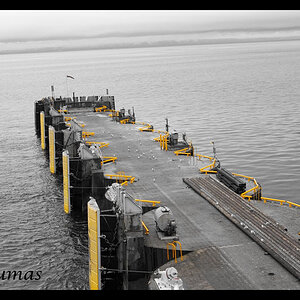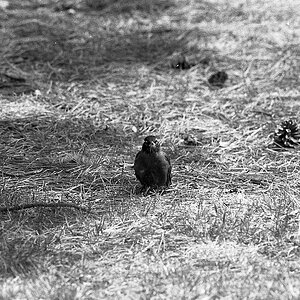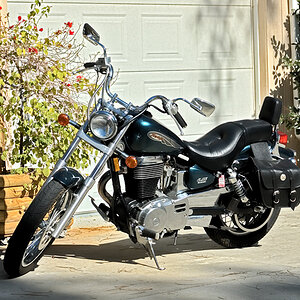VidThreeNorth
No longer a newbie, moving up!
- Joined
- Oct 21, 2016
- Messages
- 1,172
- Reaction score
- 212
- Can others edit my Photos
- Photos NOT OK to edit
Rewind your head back about 10 years and video was still mainly about DVD's and 1080p was a "big deal". I don't know offhand what a typical bitrate was back then. At 720p it might have been 7 - 8 mbps. When Full HD (1080i) started showing up, it tended to be around 17 mbps. As time went by the better cameras got denser, and today, it is not unusual to find 20 - 24 mbps at 24 - 30 fps. At 60 fps you usually see around 28 mbps. Then we get the jump to UHD, and suddenly for 24 - 30 fps, 100 mbps is typical. Ok, H.265 is already here and you get smaller files, but nobody likes to edit H.265 because your computer bogs down. Personally, at UHD, I'd prefer to stay with H.264 files like XAVC-S (and other similar variants).
[2020-02-29 9:37]
Actually, DVD's were not H.264, they were H.263 which was less efficient compression resulting in much higher file sizes for the same detail level -- though at maximum detail, the differences between compression methods reduces. Also, the methods do not translate that directly. If you try to re-compress the old type of file with H.264 to the same detail level the resulting file is actually larger than the original file. One needs to start from the same source material to end up with the same detail level using the newer compression to end up with a smaller equivalent file. However, if you record fresh in 720p with H.264, at the same detail level of common DVDs, then the resulting data rate would probably be what I suggested.
I think Sony got this much right. Right now, Sony has filled in the "hole' at 50mbps two ways. First, they brought XAVC-S to consumer grade cameras with file sizes of around 50 mbps at 24 - 30 fps 1080p. Then they followed that up with UHD at 60 mpbs at 24 - 30 fps.
If you look at the Panasonic G7 and G85 (and I think the G95), you still have that jump at 24 - 30 fps from 1080p 24 mbps to UHD 100 mbps. If you check the other big camera companies (Canon, Nikon and Olympus), I have not checked every model, but I'm fairly certain that you see something similar. There might be hope for the latest Canons (M6 Mk II) which might have a smaller bit-rate UHD. I have looked but did not find that spec.
The Market Gap:
There appears to be a gap growing in the video market. On the one hand, Netflix is leading a deliberate push into 4K. On the other hand, YouTube does not push anything, and the viewers have shown that UHD is not necessary. Recently the Northrups made a video saying that 4K had "failed" and they are dropping back to 1080p for their YouTube channel. Actually, I have not seen many photographic vlogs that have been posting in 4K lately. Considering these are people who "know image quality", it speaks volumes. People who know pictures and video have generally not bothered to vlog in 4K -- except on occasion when they had something special to show.
That does not mean there is "no case" for 4K, but there definitely is subject matter that does not warrant 4K. And why should it when everyone who cares about the numbers says that people mainly watch YouTube on handheld devices with small screens? And further tipping the scales is the fact that many are watching through wireless, which makes lower data rates more reliable?
Producing for 1080p seems to be the best compromise target, and again, at data-rates lower than 24 mbps. So 24 mbps is a good enough capture format. But if you want more flexibility, the jump to 100 mbps is still there. Why not provide more options at around 50 mbps? I have pointed out before that the NTK65556 based cameras have developed a 2880 x 2160 @ 24 fps anamorphic 16:9 format which I have used in my Git2. This can often be converted and edited in with 3640 files and will look acceptable. If camera companies are still doubtful about that format then there is also 2560 x 1440, which is a viewable option on YouTube. Yes, it is an existing "supported" option in the real world -- except from major camera companies. For people targeting Full HD final output, the 1440p option gives most of the advantages of UHD, and saves data space, and probably camera battery life. 1440p could used with data-rates from around 35 mbps up to around 60 mbps.
As for me, having worked with Sony's XAVC-S for 1080p at 50mbps on my cheap CX405 camcorder, I cannot say that I am entirely happy with it, but I might be heading in that direction for the near future. The YiM1 with its 80 mbps UHD has been a limited success. Unfortunately, the camera does not have sufficient controls. It has no controls for contrast, saturation nor sharpening -- at all. Neither in still nor in video. For still it makes no difference because I can word from a raw file. But for video, it means that there is only a very limited range of "near ideal" lighting in which it can work. I can try my Sony cellphone 60mbps UHD. I used it years ago in a test. That might work out fairly well. If so, then the new Sony a6100 or a6400 might be viable options. Beyond that, other camera manufacturers should take another look at what they have produced. There needs to be more options than just these.
[2020-02-29 9:37]
Actually, DVD's were not H.264, they were H.263 which was less efficient compression resulting in much higher file sizes for the same detail level -- though at maximum detail, the differences between compression methods reduces. Also, the methods do not translate that directly. If you try to re-compress the old type of file with H.264 to the same detail level the resulting file is actually larger than the original file. One needs to start from the same source material to end up with the same detail level using the newer compression to end up with a smaller equivalent file. However, if you record fresh in 720p with H.264, at the same detail level of common DVDs, then the resulting data rate would probably be what I suggested.
I think Sony got this much right. Right now, Sony has filled in the "hole' at 50mbps two ways. First, they brought XAVC-S to consumer grade cameras with file sizes of around 50 mbps at 24 - 30 fps 1080p. Then they followed that up with UHD at 60 mpbs at 24 - 30 fps.
If you look at the Panasonic G7 and G85 (and I think the G95), you still have that jump at 24 - 30 fps from 1080p 24 mbps to UHD 100 mbps. If you check the other big camera companies (Canon, Nikon and Olympus), I have not checked every model, but I'm fairly certain that you see something similar. There might be hope for the latest Canons (M6 Mk II) which might have a smaller bit-rate UHD. I have looked but did not find that spec.
The Market Gap:
There appears to be a gap growing in the video market. On the one hand, Netflix is leading a deliberate push into 4K. On the other hand, YouTube does not push anything, and the viewers have shown that UHD is not necessary. Recently the Northrups made a video saying that 4K had "failed" and they are dropping back to 1080p for their YouTube channel. Actually, I have not seen many photographic vlogs that have been posting in 4K lately. Considering these are people who "know image quality", it speaks volumes. People who know pictures and video have generally not bothered to vlog in 4K -- except on occasion when they had something special to show.
That does not mean there is "no case" for 4K, but there definitely is subject matter that does not warrant 4K. And why should it when everyone who cares about the numbers says that people mainly watch YouTube on handheld devices with small screens? And further tipping the scales is the fact that many are watching through wireless, which makes lower data rates more reliable?
Producing for 1080p seems to be the best compromise target, and again, at data-rates lower than 24 mbps. So 24 mbps is a good enough capture format. But if you want more flexibility, the jump to 100 mbps is still there. Why not provide more options at around 50 mbps? I have pointed out before that the NTK65556 based cameras have developed a 2880 x 2160 @ 24 fps anamorphic 16:9 format which I have used in my Git2. This can often be converted and edited in with 3640 files and will look acceptable. If camera companies are still doubtful about that format then there is also 2560 x 1440, which is a viewable option on YouTube. Yes, it is an existing "supported" option in the real world -- except from major camera companies. For people targeting Full HD final output, the 1440p option gives most of the advantages of UHD, and saves data space, and probably camera battery life. 1440p could used with data-rates from around 35 mbps up to around 60 mbps.
As for me, having worked with Sony's XAVC-S for 1080p at 50mbps on my cheap CX405 camcorder, I cannot say that I am entirely happy with it, but I might be heading in that direction for the near future. The YiM1 with its 80 mbps UHD has been a limited success. Unfortunately, the camera does not have sufficient controls. It has no controls for contrast, saturation nor sharpening -- at all. Neither in still nor in video. For still it makes no difference because I can word from a raw file. But for video, it means that there is only a very limited range of "near ideal" lighting in which it can work. I can try my Sony cellphone 60mbps UHD. I used it years ago in a test. That might work out fairly well. If so, then the new Sony a6100 or a6400 might be viable options. Beyond that, other camera manufacturers should take another look at what they have produced. There needs to be more options than just these.
Last edited:






![[No title]](/data/xfmg/thumbnail/42/42493-2665d3a35f26795cc783aeb77329a032.jpg?1619740197)


![[No title]](/data/xfmg/thumbnail/32/32926-ec27ecead8c80d803404500d8f888dbf.jpg?1619735754)


![[No title]](/data/xfmg/thumbnail/35/35213-19b5e1596f756d523bfde9446f21ca8a.jpg?1619736951)
